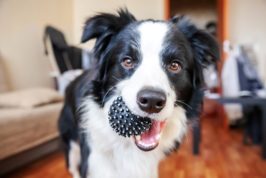Walking a dog with a Luxating Patella
One of the most common joint conditions in dogs is a Luxating Patella. But what exactly is a Luxating Patella, and what should you do if your pet is diagnosed with one? Our guest author, Dr Joanna Woodnutt, explains all…
What is a Luxating Patella?
Your dog’s patella is the kneecap – the bone that sits over the knee and moves back and forth when it bends its hind legs. The patella sits inside a ligament that attaches to the thigh bone (femur) and the shin bone (tibia). When the knee is bent and straightened, the patella should slide up and down a groove in the femur, called the trochlear groove, or patella groove. A Luxating Patella is a kneecap that dislocates or ‘pops out’ of this groove. Usually, the patella will ‘pop’ inwards to rest on the inside of the knee, known as a Medial Luxation.
Patella Luxation is a common problem for canines, especially in Pomeranians, French Bulldogs and Chihuahuas, and affects more females than males. My own terrier, Pixie, has a Luxating Patella. It’s usually caused by some or all of the following…
- A growth deformity causing bent leg bones
- Hip Dysplasia
- Over-tight or under-muscled quadriceps muscles
- The groove in the femur being too shallow
- A mis-shaped tibia, with the area that the patella ligament attaches to in the wrong place
In almost all dogs, a Luxating Patella is due to these growth deformities, so it’s considered to be an inherited condition. That said, a Luxating Patella can occasionally be caused by a traumatic injury.
How does your vet know your dog has a Luxating Patella?

The signs of a Luxating Patella in a dog are easily recognisable. Most owners describe a ‘bunny hop’ movement, or a dog that will ‘skip’ on three legs for a few paces, then revert to using four, with no obvious signs of pain between. Because dogs with Patella Luxation show few signs of pain, I find that pet parents may even be unaware their dog has a problem!
Your vet may be able to diagnose a Luxating Patella based on likelihood. These signs, in the right age and breed of dog, make Luxating Patella the likely conclusion. Your vet may even be able to pop the patella out of position in the exam room, confirming the diagnosis. Your vet will ‘grade’ the severity of the Patella Luxation, based on how easily it slips out. Grade I (one) is the least severe, while Grade IV (four) is the most.
Some dogs, especially those who aren’t showing typical signs or aren’t an ‘at-risk’ breed, may need x-rays to help with diagnosis. This also allows your vet to make sure your dog isn’t suffering from other conditions at the same time, such as issues with the cruciate ligament or Arthritis. In my Pixie’s case, she’s just a Grade I, but she still has a high risk of snapping her cruciate ligament inside her knee one day.
Treating a Luxating Patella
If your dog is diagnosed with a Luxating Patella, your vet will discuss the treatment options available to you. For some dogs with a more severe problem (Grades two, three or four), or dogs with cruciate problems, surgery will usually be recommended.
In Patella Luxation surgery, the bones are cut and reset to stretch the ligament more tightly over the joint. With a tighter ligament, the patella will be less free to move outwards. The groove may also be deepened, so it’s harder for the patella to pop out.
Many dogs with a low-grade patella issue may go on to have ‘conservative’ or ‘medical’ management only, instead of surgery. While a Luxating Patella will make dogs more likely to have Arthritis in future, surgery is not always the best option.
Home care for dogs with a Luxating Patella
There are lots of things you can do to help a dog with a Luxating Patella exercise safely and reduce the pressure on their bad knee.
Weight management
Carrying excess weight puts extra strain on sore joints, and makes your dog more prone to lots of other diseases. Getting your dog to an ideal weight is one of the most important things you can do to help with a Luxating Patella.
Research shows that it’s easy to underestimate your dog’s weight, so make sure you ask your vet if your dog’s weight is ok. If they do recommend weight loss, it’s worth putting in the effort — your dog will be much happier for it!
Choosing the right type of exercise
For many pets with Patella Luxation, a long, leisurely walk will be better than a run. Pick your exercise surface carefully, too. Hard surfaces, such as roads, will have more impact on the joints than soft surfaces, and slippery surfaces (like mud) should also be avoided. Avoid repetitive ball throwing and things that involve jumping and twisting.
Walking uphill is really good exercise for the back legs. Unfortunately, in my experience, heading back downhill is a little more uncomfortable on your dog’s knees. If you find hills are too hard for your dog, don’t push them!
Many owners find hydrotherapy useful, and I regularly refer animals to an underwater treadmill – this allows exercise to improve muscle strength without straining the joint further.
Physiotherapy is also useful. I particularly like encouraging dogs to step over low hurdles, as a way to exercise their hind leg muscles. A canine physiotherapist may be able to give you muscle-strengthening exercises to do with your dog at home.
How often should you exercise your dog?
With joint disease, little and often is usually better than ‘overdoing it’. Dogs with Patella Luxation are likely to benefit from frequent (at least daily) exercise, in order to keep their muscles in good condition.
Warm up routines are important
One of the worst things you can do for your dogs is let them leap out of the car and charge off after a ball or a squirrel. Sudden, high-impact exercise like this can damage cold muscles, increasing the chance of injury — especially if they already have a joint that’s not perfect.
It’s usually best to spend about 10 minutes doing gentle exercise before you let your dog run – a walk on the lead is fine. For some dogs, you may also want to do some low-level physiotherapy at home before you take them outside. Ask your veterinary team or a canine physiotherapist for the best option for your dog.
Medications for treating a Luxating Patella in dogs
If your dog isn’t suited to or in need of surgery, it’s likely you’ll need medication to help reduce pain and inflammation, and increase the general health of the joint. Your vet may recommend or prescribe:
- A joint supplement (usually containing Glucosamine, Chondroitin, Hyaluronic Acid and a source of Omega 3)
- A Non-Steroidal Anti-Inflammatory Drug (NSAID) to reduce pain and inflammation
- Other prescription pain-relief medications, such as Tramadol, Codeine or Gabapentin
Other things that may help your dog with Patella Luxation
Here are a few other things that can help your dog with Patella Luxation, depending on the situation…
- A knee brace is sometimes recommended, but this can lead to the quadriceps becoming weaker. They are best used temporarily, for traumatic disease where surgery isn’t an option
- Ice packs (cryotherapy) may also be recommended for traumatic joint problems
- Trim your dog’s nails and the fur between the pads, to ensure they aren’t changing the way your dog bears weight
- Consider your dog’s home environment — using ramps to help them get into the car can reduce pressure on joints, and rubber-backed mats can stop slips on hard floors
Conclusion
Patella Luxation doesn’t always result in surgery, but that doesn’t mean that nothing can be done to help your dog’s knees and slow the onset of Arthritis! Remember, the goal isn’t to prevent your dog from doing anything. Instead, you want to maintain the muscle on their hindquarters while reducing impact on the joint.






How is she doing? Did she recover without surgery?
Ian B …. my vet was critical of braces as well.
But my 7lb silky poo had a partial Tear. I didn’t listen to him.
Spent 1k on a brace that didn’t properly fit her
little chicken wing of a leg. It was a waste but perhaps for big dogs it works.
Rest rest rest is key. Got her joint supplements. And well 2 years later she’s
ok. Running and jumping. Though I try to limit all that. Best of luck to you.
All cases are unique.
It really is unique case by case! Great to hear she is able to move around comfortably now. What joint supplements do you give her? – Fiona
[…] Research shows that it's easy to underestimate your dog's weight, so make sure you ask your vet if your dog's weight is ok. If they do recommend weight loss, it's worth putting in the effort — your dog will be much happier for it! For many pets with Patella Luxation, a long, leisurely walk will be better than a run. via […]
We couldn’t agree more – keeping your dog at the right weight makes a real difference to their joint health overall.